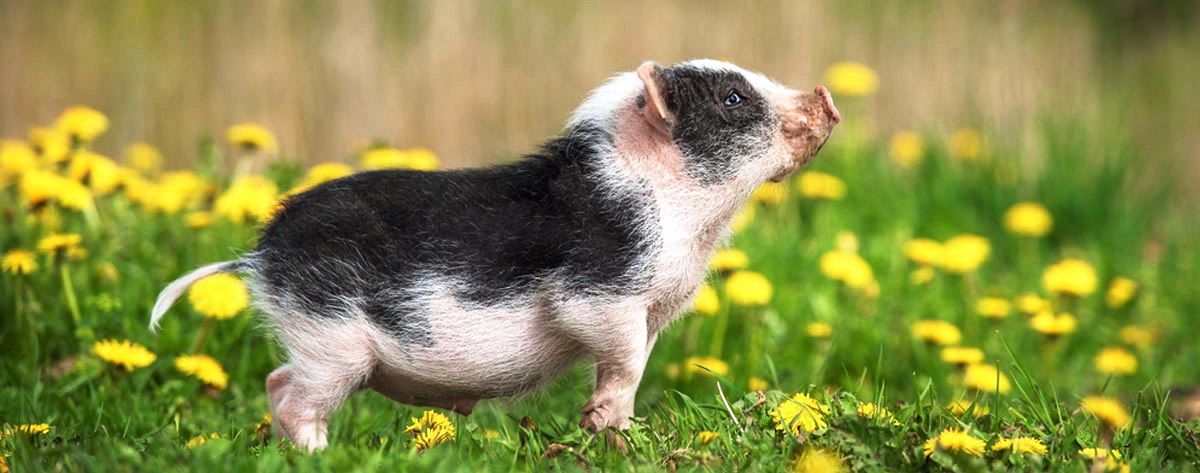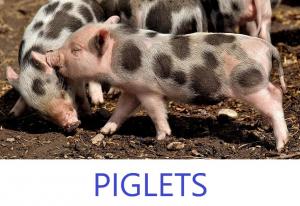LCR Miniature Pigs
Lucky Creek Ranch set about breeding Mini Pigs in 2017 with the goal of creating friendly, solidly built, small statured pigs that mature to a weight of less than 100lbs and height under 13 inches tall. We are currently (as of 2021) on generation 5 and have accomplished our goals with the added bonus of removing much of the typical “pot belly” and “sway back” from our lines to create a more compact, blockier pig less prone to back issues in later life.
*Beware* Not All Mini Pigs are actually Mini Pigs
As a piglet it is impossible to tell the difference between a large pot bellied pig and miniature pig; as with all livestock genetics will determine what natural attributes they possess to include size. It is not at all uncommon for some individuals to market a full sized “pot belly pig” as a mini-pig and dupe unsuspecting buyers into purchasing a large animal that may have an adult weight 300lbs or more. Always ask to see the piglets parents and preferably grandparents to get a more realistic idea of what adult size may look like. Since pigs are prolific breeders and can produce litters years before they are physically mature, unscrupulous breeders may show off parent pigs that have yet to reach their full adult size and are not fully grown themselves. By asking to see the grandparents you are at least gaining the ability to see one more year of growth and see if a wide disparity exists between the current parent and a more physically mature version of them. At LCR our retired pigs are pastured to live out their days and make them available for viewing; currently we have 3 generations on site.
Pet Status
Additionally and certainly of great help to the acceptance of small pigs as a house pet is that they are as affectionate as a dog and as smart or smarter than the average dog whilst also being consider hypoallergenic. Therefore, people who have to deal with allergies or asthma that would prevent them from owning a dog, cat, rabbit etc. can get a pig without any problems. Miniature pigs are also no more difficult to potty train than a dog or cat and will happily use a litter boxes with pine pellets or pine shavings; some will even go in an out like a dog via a pet door. The one caveat to housebreaking a male pig is that he “must be” neutered as intact pigs are incredibly difficult to housetrain as they are hormonally driven to leave scent markers throughout their territory to both mark it and attract a mate; all LCR male mini-pigs are neutered prior to leaving the farm for their new home.
Make sure to research your local laws and ordinances as some jurisdictions consider pigs to be exclusively a livestock animal; accordingly you may not be able to legally own one in a residential area.
Piglet Placement and Reservation Policy
- A non-refundable deposit of $100 is required to reserve a piglet; the deposit amount will be applied toward payment of the total purchase price upon sale completion.
- Upon receipt of deposit, a pick-up date for your new piglet will be provided; pigs not picked up or shipped within 7 days of pickup/shipping date will be re-listed for sale with deposits and money forfeited. Piglets are considered weaned at 6 weeks and will need to be picked up as agreed.
- Pigs will not be considered “sold” until full payment has been made and Purchaser takes possession the piglet.
- Purchaser shall pay any and all shipping costs involved in transporting the piglet.
- Purchaser agrees to return signed contract to seller prior to scheduled pickup or shipping date.
- Purchaser agrees to participate in a telephone interview to answer questions and provide information relating to the placement of piglets into the Purchaser's home.
- Purchaser is to be available by email, telephone or text for input and decisions regarding pig/piglet such as emergencies, medical care or transportation arrangements.
- Cancellation of sale by the Purchaser or failure to comply with the terms and conditions stated in this Deposit Policy will revoke the piglets reserved status and forfeit the deposit and/or other monies. Forfeited money or deposits are not transferable to another pig. Forfeited amounts are to be considered compensation, paid to Seller for costs and losses incurred as a result of not having been able to offer the reserved piglet to prospective buyers.
- Piglets are sold for pets and not as breeders or for resale. All Male pigs will come neutered, and no unneutered males will ever be offered for sale. Female pigs will come with a spay contract; this contract is not negotiable and requires purchaser to have a licensed veterinarian spay their piglet before to 6 months of age. Purchaser agrees to supply Seller with a veterinarian's letter by mail as proof of a spay within after surgery.
Please check our General Livestock Sales Policy page for any questions that may not of been answered or items that may have been missed.
History of the Breed
Miniature Pigs, AKA, Micro Pigs, Teacup Pigs, Pigmy Pigs are basically small statured domestic pigs bred specifically for use as a pet and were derived from generations of cross breeding Vietnamese Pot-Bellied pigs, Göttingen minipigs, Juliana pigs, Choctaw hogs, and the Kunekune (and then further breeding the descendents of these initial crossbreedings).
As for the specific genesis of the American Mini Pig most agree that during the 1960’s small Chinese pigs with mature weights of fewer than 150lbs found themselves in demand as exhibits by western zoos. From here and due to their small size which made them easier to handle and cheaper to maintain than full sized pigs which could weigh 300-500lbs they gained popularity with medical laboratories for testing and as a source of organs for organ transplantation. Beyond this the method by which they gained relatively common house pet status isn’t really known. What we do know is that in the 1980’s, a Canadian, Keith Connell of the Bowmanville Zoo in Ontario imported a breeding pair of Vietnamese Pot-Bellied pigs, which many claim to be the foundation stock of the modern North American pot-bellied pig. The offspring of these would undoubtedly have been bred with existing pet pigs already in North America over a number of generations to provide us with the diversity and smaller size that we have now.


